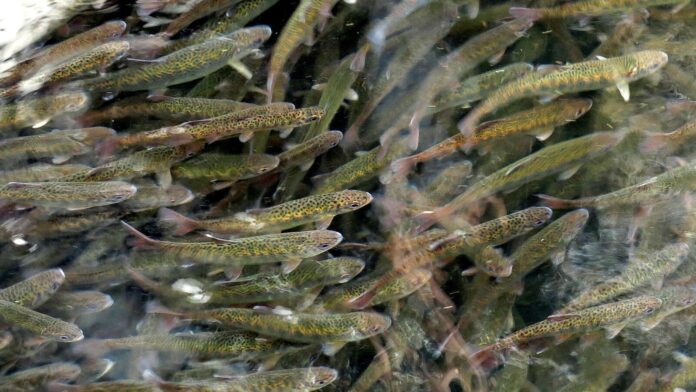BOISE, Idaho — The U.S. government will invest $240 million in salmon and steelhead trout hatcheries in the Pacific Northwest to boost declining fish populations and support treaty-protected fishing rights for Native American tribes, officials announced Thursday.
The Departments of Commerce and Interior said an initial $54 million will be made available for the maintenance and upgrading of nurseries to 27 tribes in the region, including Oregon, Washington, Idaho and Alaska.
The hatcheries “produce the salmon that tribes need to live,” said Jennifer Quan, regional administrator for NOAA Fisheries West Coast Region. “We’re talking about food for the tribes and supporting their culture and their spirituality.”
Some facilities are on the verge of collapse, Quan said, with a backlog of deferred maintenance estimated to cost more than $1 billion.
“For example, the roof of the Makah Tribe’s Stony Creek facility is literally a tarp. The Lummi Nation Skookum Hatchery is the only hatchery that produces native Chinook salmon in the spring in our Puget Sound Chinook salmon recovery,” and it’s collapsing, Quan said.
The Columbia River Basin was once the largest salmon-producing river system in the world, with at least 16 salmon and steelhead populations. Today, four are extinct and seven are listed under the Endangered Species Act. Salmon are an important part of the ecosystem, and another endangered species in the Northwest, a population of killer whales, depends on Chinook salmon for food.
Salmon are born in rivers and migrate long distances downstream to the ocean, where they spend most of their adult lives. They then make the difficult journey back upstream to their birthplace to spawn and die.
The dams in the Columbia Basin have played a major role in destroying wild fish migrations, cutting off access to upstream habitat, slowing water flow and sometimes even reaching temperatures that are lethal to fish.
For decades, state, federal and tribal governments have tried to replenish declining fish populations by building hatcheries to raise and hatch salmon that are later released into the wild. But multiple studies have shown that hatchery programs often have a negative impact on wild fish, in part by reducing genetic diversity and increasing competition for food.
Quan acknowledged that the farms “carry risks,” but said they can be managed to produce additional fish for harvest and even help populations recover, while minimizing risks to wild fish.
“Hatcheries have been around for a long time and we have seen how much damage they can cause,” Quan said.
Yet the programs have changed course in recent years, following genetic management plans and principles established by scientific review groups, she said. “We’re in a different place now.”
It will take habitat restoration, improved water quality, harvest adjustments and other steps if salmon are to recover, but so far society has been unwilling to make the changes needed to make that happen, she said. Add the effects of climate change, and the equation for bad versus good farms has even more implications.
“We need to start a conversation about nurseries and how they are going to be an important adaptation tool for us in the future,” Quan said.
Greg Ruggerone, a salmon researcher with Natural Resources Consultants Inc. in Seattle, said the key is determining how to better harvest farmed salmon from rivers without harming wild salmon that make the same journey to spawning grounds. Robust harvests of farmed fish will help ensure the federal government meets its treaty obligations to tribes while reducing competition for wild fish, Ruggerone said.
“A major goal of the farms in the Pacific Northwest is to provide the harvest – particularly the harvest for the tribes – so there is a big opportunity if we can figure out how to harvest without harming the wild salmon,” Ruggerone said.
According to Becky Johnson, director of the Nez Perce Tribe’s Department of Fisheries Resource Management’s production division, every farm in the Columbia River watershed was built to mitigate the impacts of the region’s hydroelectric dams.
Most were built in the 1960s, 1970s or earlier, she said.
“I’m super excited about this opportunity. Tribes and non-tribes benefit — more salmon returning to the basin means more salmon for everyone,” Johnson said. “It’s critical that we have fish and that tribal members have food. Tribal members will tell you they fight hard to keep catching fish, and they never give up that fight.”



